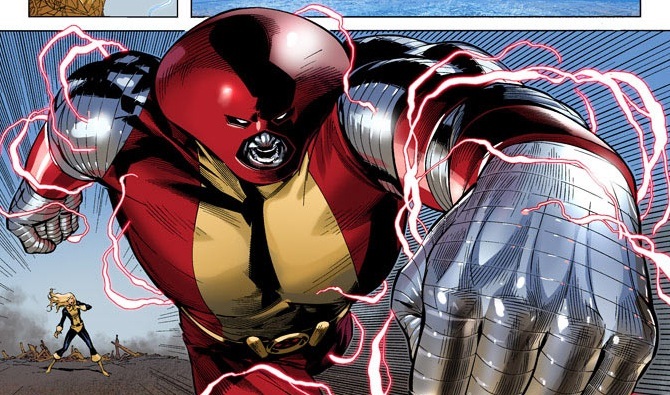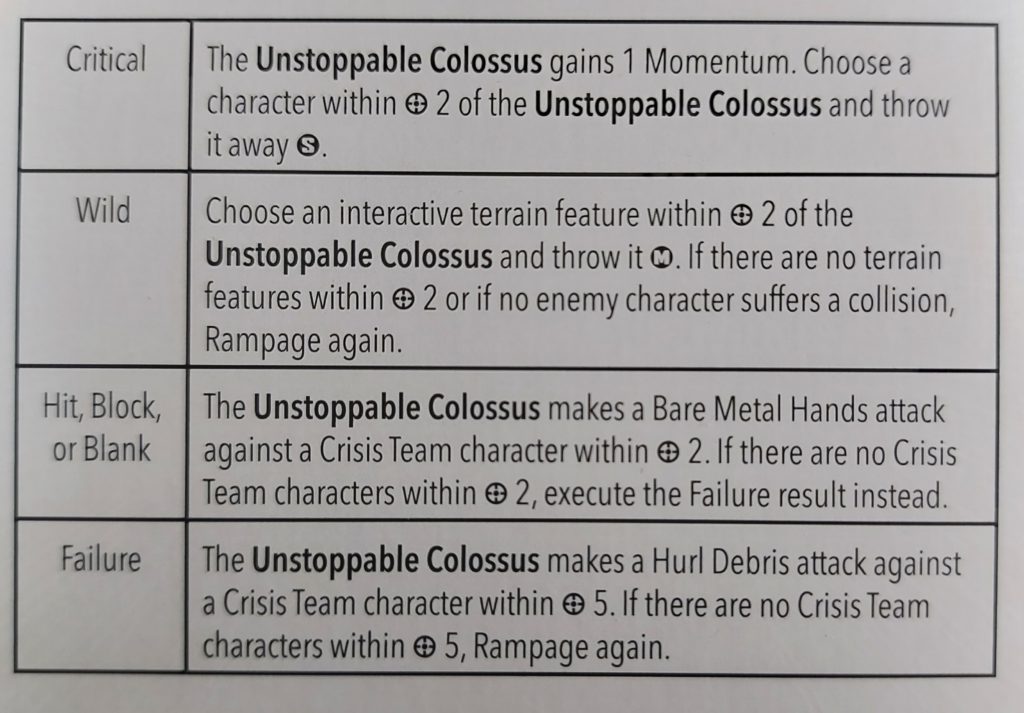
Colossus has touched the Crimson Gem of Cyttorak and attained powers comparable to the juggernaut! He has lost control and is rampaging through the city, destroying all in his path. The faster he gets the more aggressive he becomes – it’s down to you to slow him down and bring him under control.
It’s been a while since I did an article on an Ultimate Encounter, and since I recently acquired and played this one I thought I would put finger to keyboard and break it down a little as, personally, I struggle a bit with the AMG UE rules leaflets having rules spread out throughout the booklet and tip cards rather than in one single place. It may work well for some people, but I find that I have to jump about too much and it takes me ages to get the rules in my head.
So, let’s get into it and see what this UE brings to the game.

THE BASICS
This UE is a 2-player with an automated Colossus acting as the Cosmic Threat. Throughout the game Colossus will be rampaging in randomised directions and it is down to the crisis teams, under the guidance of Professor Xavier, to use Cerebro Towers to set up a series of psychic barriers in order to slow him down and bring him under control.
There are 4 difficulty levels to the mission and the levels dictate how many team tactics cards the crisis players can take into battle, and how many subdue tokens the Crisis Team have to put onto Colossus (more on that later), meaning that the game can be scaled to match the experience of the players involved. Personally I found that the narrative and normal modes can be won quite regularly with some good play, and found hard and unstoppable mode to be… well… hard.
Whilst rampaging about Colossus will be destroying pretty much everything he touches, so the recommendation is to have a battlefield littered with terrain of all sizes, with a particular focus on the centre of the board.
There are a few ways the game can end – if Colossus ever destroys all six Cerebro Towers, or if the Crisis Team manage to subdue Colossus the number of times specified by the game difficulty.
Before we get into any more specifics let’s just briefly go over how a UE works for those who haven’t played one before.
GAMEPLAY
Fielding Squads
To build the battlefield the 6 Cerebro Towers are placed randomly as shown on the map layout in the rules booklet, and Colossus’ momentum is set to 9 on the momentum tracker. Then the randomizer tokens are shuffled and laid out along the bottom of the momentum tracker, and the first token is flipped to reveal its number (there’ll be more on this later).
After building the battlefield Colossus (not the Juggernaut mini – this is not specified in the rules but was clarified by AMG) is deployed in the centre of the map. Then, one player picks a corner of the board to deploy in and places their characters within range 3 of that corner. The other player then deploys their characters within range 3 of the opposite corner.
Each team can use an affiliation, but each affiliation only affects characters within their team. However, team tactics cards can be used across the teams. For this encounter the maximum threat level for each squad is 17. These two squads together are collectively referred to as the “Crisis Team”, and when playing the game the Crisis Team players will be working together to fulfil their objectives.
Round Structure
The round structure for an ultimate encounter is slightly different than usual gameplay. First, we start off with the power phase as normal. Then power phase player effects occur starting with the player with priority (in this case always the Crisis Team players), then power phase encounter or status card effects are resolved (more on those later). Once all of this is done players can move on to the activation phase.
During the activation phase the Crisis Team may activate 3 characters consecutively, adding activation tokens as usual once complete. After the third character has activated, Colossus then activates. This 3-then-1 type activation repeats until it has occurred three times, then the activation phase ends and the cleanup phase begins.
Note that if a Crisis Team squad with a large body count has been fielded then not all characters will get to activate during the 3 activation “windows.” It is also worth noting that a round does not work as normal within the ultimate encounter ruleset, instead a round lasts until the end of the next turn by the Cosmic Threat/Ultron player.
Once in the cleanup phase proceed as normal, resolving cleanup phase effects, flipping dazed characters to their injured side etc. Additionally, any Crisis Team character without an activated token now gets to make a short move for free, yay!
PLAYING THE UE
Cerebro Towers & Psychic Beams
As has previously been stated the Crisis Team are focused on getting to Cerebro Towers so that they can setup psychic beams which will slow Colossus down. The usual rules for interaction with tokens applies (be within range 1, pay 1 power), and when activated you get to place a disruption beam token pointing from the tower that you are interacting with towards any other tower. Once two towers have been activated in such a way that 2 disruption beam tokens are pointing towards each other the Cerebro Towers are linked and the corresponding disruption beam is active. One handy tip for this – camp a character on a tower for a few rounds and setup 2 or 3 disruption beam tokens whilst other characters run around setting up the corresponding beam.
Whenever Colossus moves if his base or the movement tool would cross any straight line drawn between two linked Cerebro Towers then his momentum is decreased by 3 and the disruption beam tokens associated with this link are removed from the board. This can occur multiple times in a single move if he crosses multiple disruption beams. Speaking of momentum…
The Momentum Tracker

The momentum tracker is the heart of this UE. If you recall earlier on the randomizer tokens were shuffled, placed in position along the bottom of the momentum tracker and then the first one was flipped to its numbered side. The number revealed is the Cerebro Tower number which Colossus is rampaging towards. He has one mission – destroy all the towers!
The game starts with Colossus on the number 9 space on the momentum tracker. The momentum tracker controls how far Colossus moves, how many additional attack and defence die he can use, and how much damage crisis team members take if they get caught in the path of one of his rampages. These criteria are listed to the right of the numbered momentum spaces. All of these criteria change depending on how much momentum Colossus.
Let’s explain a bit further. Once the Crisis Team has completed activating its 3 characters it becomes Colossus’ turn. The first thing he does is rampage towards the current priority Cerebro Tower as identified by the flipped randomiser token. This rampage uses the movement tool equal to the momentum level, so the long tool for levels 7-12, medium for levels 4-6 and short for levels 0-3. Colossus does not stop if he contacts any interactive terrain, instead this terrain is destroyed and Colossus movement continues. If Colossus contacts Crisis Team characters during this move he does not stop, his move continues and the character(s) take damage corresponding to the amount identified on the momentum level on the moment tracker (4 for levels 10-12, 3 for levels 7-9, 2 for levels 4-6 and 1 for levels 0-3). Lastly, if Colossus contacts a Cerebro Tower it is destroyed and Colossus stops moving. The next randomiser token is flipped and this identified the next Cerebro Tower which Colossus will next rampage towards. Note that all Crisis Team characters within range 1 of the destroyed Cerebro Tower suffer 2 damage and gain 2 power. Once this rampage is done it’s time to roll a die on the rampage chart and resolve the roll:

Colossus then activates as normal (2 actions to resolve) before the Crisis Team get their next round of activations.
A game of this UE involves a lot of back and forth on the momentum tracker, with Colossus trying to get more and more momentum and the Crisis Team trying to bring him down and subdue him. There are various ways to change the momentum level on the tracker and these are:
- Colossus gains 1 momentum after each time he rampages if one or more terrain features of size 2 or greater were destroyed during the rampage.
- Colossus gains 1 momentum each time a Crisis Team member is dazed or K.O’d.
- Colossus loses 3 momentum each time he crosses or overlaps a Disruption Beam.
- Colossus loses 1 momentum each time he suffers damage.
So as you can see, staying out of Colossus way is wise – focusing on Disruption Beams and occasional chip damage is the name of the game for the Crisis Team.
If the Crisis Team manage to get a few disruption beams in Colossus’ way and do a bit of damage to him then they may be able to get his momentum to 0. Well done – Colossus is subdued! Add a subdue token to his stat card and remove all damage and effects from him. And joy of joys he rampages using the short movement tool! Once this rampage is done his momentum goes right back up to 9 and you start all over again. The Crisis Team will need to keep doing this until they have the number of subdue tokens on Colossus equal to the chosen game difficulty mode (2 for narrative, 3 for normal, 4 for hard and 5 for unstoppable). Yeah, it’s tough.
The Unstoppable Colossus
Before we close off this look into the Unstoppable Colossus UE we need to look at Colossus’ stat card as it has a few things that affect gameplay.

First let’s look at this stats. He has 90 stamina. That’s ridiculous. You aren’t ever going to daze or K.O him. He has no movement as this is all controlled by the momentum tracker. Bear this in mind when doing Colossus’ two activations as he won’t be able to move again once he has rampaged. He’s size 3 which is normal enough. For defences he has 4’s right across the board, but remember that he gets additional defence dice based upon his momentum level (+3 for levels 10-12, +2 for levels 7-9, +1 for levels 4-6 and +0 for levels 0-3). If things aren’t going too well for the Crisis team them Colossus could be rolling 7 defence die. Weep. Just in case he wasn’t robust enough he is also immune to… everything. No fun with incinerate to be had here alas.
Let’s move onto his attacks. Bare Metal Hands is his most basic attack and is physical, has a range of 2 (or of A2 if the momentum tracker is at level 7 or higher), strength of 8 and power cost of 0 (Colossus doesn’t gain power in this UE). If this attack deals damage (pretty darn likely given it’s strength) then once it is resolved Colossus may throw the target character away short. Bear in mind that in this game there is a rule that the players must do whatever is worse for the Crisis Team when controlling Colossus. This is not a pleasant attack to be on the receiving end of, especially when you consider that this attack is also triggered by rolls on the rampage table.
Attack number 2 is just as brutal – another physical attack, this time called Hurl Debris. It has a range of 5 (WHY?!), strength of 8 and power cost of 0. If this attack deals damage then you add 1 momentum to the momentum tracker. Gee, thanks!
And best of all, Colossus gets extra attack dice based on his momentum level just like with his defences! This is all thanks to his Helmet of Cyttorak superpower. So not only is he able to roll up to 7 defence dice, he can also lay into you twice a turn with 11 dice! Just to rub some salt into the wound this superpower also states that Colossus cannot be moved by Crisis Team effects. No throwing or pushing him i’m afraid. Greeeeeaaaat.
But wait, it gets better – let’s take a look at his Organic Steel superpower. When Colossus would suffer damage from an enemy effect reduce the amount suffered by 1 to a minimum of 1. After the effect is resolved remove all damage from this character. If you recall from earlier Colossus loses 1 momentum each time he suffers damage. it doesn’t matter how much damage you lay into him, he only ever take 1. Right at the beginning of this article I mentioned it is handy to take a few heavy hitters – sometime you just need to roll ALL OF THE DICE just to get a damage on him and bring his momentum level down.
That’s it for Colossus’ stats, let’s finish this article with a summary of my thoughts.
SUMMARY
I have played this UE quite a few times now and I love it! Colossus is, rightly so, an absolute unit to have to deal with. I like the gameplay of all my characters running around trying to avoid Colossus, setup the beams and dive in and out to do damage rather than everyone just standing still punching each other. It’s much easier for me to get 1 additional player to join me for a game than 2 so this UE is ideal on that front, plus if you’re feeling saucy you can even play it solo. I’ve had some really swingy games with this UE too where the Crisis Team seemingly had it in the bag but then Colossus has a whopper of a turn and all is lost, only for the Crisis Team to claw it all back at the last – those type of games tell a great story and get firmly lodged in the memory. I wholeheartedly recommend this UE!
One last tip – if you want to drown in power take Magneto and use his Brotherhood leadership ability. There will be so much terrain being destroyed over the course of a game that you’ll have more power than you know what to do with.
What do you think of this Ultimate Encounter? Have you tried it, and how did it go? Leave a comment below.
Before signing off i’d like to mention Blackgate Games based in the UK. They have all the MCP range for purchase and offer huge discounts on everything. They also have lots of stuff in for other games, even Star Wars if that’s how you like to live your life. If you’re in the market for some new stuff check them out.



